Style My Sleep: Beautiful Beds Balance Comfort and Beauty
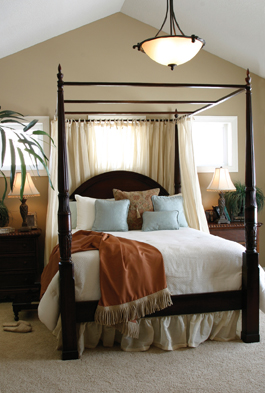 Does the sight of a luxurious, professionally made bed overwhelm you? Flip through any home design magazine or catalogue and you’re all but guaranteed to see images of bedrooms centered on a bed that’s anything but utilitarian. Perfectly pressed crisp cotton sheets, layers of fluffy duvets and quilts that look like they’d be feather-light to the touch, soft cashmere blankets folded just so at the foot of the bed…and we haven’t even mentioned the mountain of plush designer pillows.
Does the sight of a luxurious, professionally made bed overwhelm you? Flip through any home design magazine or catalogue and you’re all but guaranteed to see images of bedrooms centered on a bed that’s anything but utilitarian. Perfectly pressed crisp cotton sheets, layers of fluffy duvets and quilts that look like they’d be feather-light to the touch, soft cashmere blankets folded just so at the foot of the bed…and we haven’t even mentioned the mountain of plush designer pillows.
If you think that type of extravagance is only for those with big budgets and sky-high thread counts, think again. Well-appointed and lavish bedding is really just a matter of pausing and considering what your space needs, and what you want to enjoy, since you are the primary audience.
It all starts with an appropriately sized mattress. Choosing between a king or queen mattress is ultimately up to the sleeper(s) who will occupy it. A standard queen bed is 60 inches wide, which, if two people are sharing it, gives each person about 30 inches of room. On the other hand, a king bed is 76 inches wide, giving each sleeper an extra 8 inches to toss around in. Now, 30 inches may sound like plenty of room, but the eye-opening reality is that the standard twin bed is actually 39 inches wide. This works as a nice comparison in terms of spatial comfort.
But a sleeper’s comfort may not actually be the deciding factor. The size and layout of the room itself may have the final say in which mattress will set up reign. It’s generally best to leave at least 3 feet of room between the edge of a mattress and its surrounding walls and/or furniture. No matter how badly you want a king-sized bed, if it doesn’t fit properly in your bedroom, don’t do it. Badly proportioned furniture can quickly take a room from comfortable to cramped.
Once that decision is out of the way, thoughts can turn to the first of many decorative accents: the headboard. Upholstered, wooden, metal…options abound. Are you a modernist? Go for clean lines in uncomplicated shapes. An art deco lacquered piece in high-gloss white may be just the thing. A tufted, upholstered number in a sleek rectangular shape can be a great neutral background accessorized to suit many different aesthetic leanings.
One thing to keep in mind as you shop for a headboard is the bedroom’s architecture. If you’ve got the requisite four walls with standard 8-foot ceilings, allow your imagination to take over. However, a master suite with unique recesses and angled ceilings may put some limits on the design of the headboard. Consider a Craftsman-style home, for example, or even a Cape Cod. These architectural styles, particularly upstairs, are often sloped with custom niches and alcoves. While these features give the home character, they do pose a bit of a problem when it comes to a headboard with any kind of height. But don’t fret quite yet. If glamour and opulence aren’t achievable in an oversized headboard, you can easily compensate with great bedding.
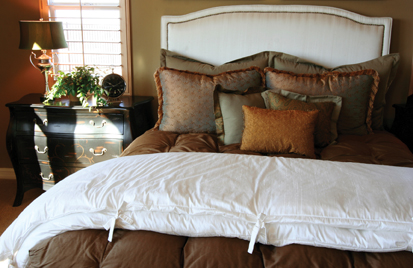 Regardless of a home’s architecture, in any design project, it’s always best to start by focusing on the base. For bedding purposes, this is typically a comforter, coverlet, quilt or duvet, depending upon your taste and need for warmth. These terms—particularly comforter and duvet—are often used interchangeably, but it’s important to understand the distinction, particularly if you’re shopping online and need to know what you’re shopping for. Duvet, the French word for comforter, generally refers to the cover that goes over a plain comforter—think of a giant pillowcase. They are often sold as “duvet covers.” So if you’re purchasing a duvet cover, you will need an insert for warmth and shape. These inserts or “comforters” can be made from down feathers or other synthetic materials. Items sold as comforters, however, are designed to stand their own, having a more polished look than the inserts for duvet covers. Coverlets and quilts, on the other hand, are often made of thinner materials, and while they do provide a polished look, you’ll need to use them in layers for warmth.
Regardless of a home’s architecture, in any design project, it’s always best to start by focusing on the base. For bedding purposes, this is typically a comforter, coverlet, quilt or duvet, depending upon your taste and need for warmth. These terms—particularly comforter and duvet—are often used interchangeably, but it’s important to understand the distinction, particularly if you’re shopping online and need to know what you’re shopping for. Duvet, the French word for comforter, generally refers to the cover that goes over a plain comforter—think of a giant pillowcase. They are often sold as “duvet covers.” So if you’re purchasing a duvet cover, you will need an insert for warmth and shape. These inserts or “comforters” can be made from down feathers or other synthetic materials. Items sold as comforters, however, are designed to stand their own, having a more polished look than the inserts for duvet covers. Coverlets and quilts, on the other hand, are often made of thinner materials, and while they do provide a polished look, you’ll need to use them in layers for warmth.
Since it’s more expensive to change out a comforter or even a duvet cover with your whims, rein in that wild side here just a touch and choose one that will stand the test of time (and changing trends). Perhaps start out with a color. Say you’ve loved the color purple your entire life. Keep an eye out for a solid or subtly patterned lavender comforter, coverlet, or duvet since it’s likely that you’ll love it for years and years to come. Allow this to be the foundation and build from it.
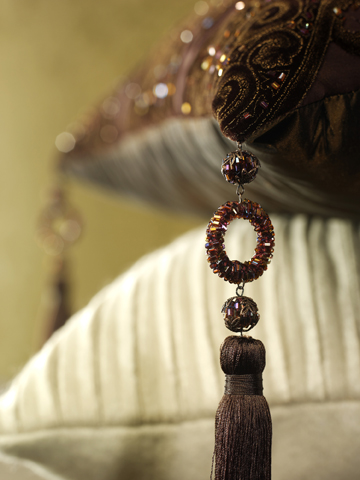 When it comes to dressing a bed, your “accessories” are comprised of things like shams, sheets and accent pillows. This is a place to think big and make bold decisions. Mix patterns and bring in a secondary color. Continuing with the purple scheme, good options for coordinating colors are green, gray, and even red. Of course, an interior designer can help you find just the right look, but if you want to do it yourself, head to the nearest home goods store. Even many of the big box stores offer great bedding selections. So grab a cart and use this contained space to test color and pattern coordination by tossing accessory pillows and sheet sets in together. This allows you to see how it all works together visually.
When it comes to dressing a bed, your “accessories” are comprised of things like shams, sheets and accent pillows. This is a place to think big and make bold decisions. Mix patterns and bring in a secondary color. Continuing with the purple scheme, good options for coordinating colors are green, gray, and even red. Of course, an interior designer can help you find just the right look, but if you want to do it yourself, head to the nearest home goods store. Even many of the big box stores offer great bedding selections. So grab a cart and use this contained space to test color and pattern coordination by tossing accessory pillows and sheet sets in together. This allows you to see how it all works together visually.
If playing with different types of pattern is of interest to you, here are few tips to keep in mind. First, stick to your original color palette. Let’s say you’ve decided to run with white, purple and gray—a little soft and sweet, mixed with hints of masculine. Scan the shelves for a pillow that jumps out at you, maybe a stripe or an ikat. Use this as your star player to choose the rest, tossing three or four options into the cart at a time.
Watch how the patterns mix, focusing on a good balance of bolder patterns with more neutral ones. Floral is back in vogue and looks gorgeous mixed with stripes, plaids or other geometrics. As long as you stick to a color scheme and remember to vary the scale of prints, it’s almost impossible to come up with a bad mix of patterns.
And don’t shy away from solids, which have a nice way of balancing the overall look. If you consider solids a bore, look for a little texture, maybe a faux fur or something with piping in a coordinating color. These elements can satisfy your bold taste without throwing off the symmetry of the bed as a whole.
How many pillows is too many? This is completely up to you. Since you’re not likely to physically sleep with these decorative beauties, just be aware that they’ll need to be removed each night and rearranged in the morning. What are you willing to work with each day? This shouldn’t become a daily headache!
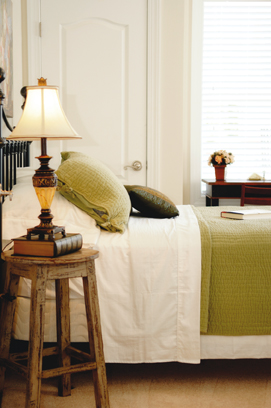 Here’s a good rule of thumb. If you have a queen bed, shoot for three pillows, whereas a king bed can handle closer to five. If that sounds like a lot, keep in mind that they don’t all have to be the same size. Mix oversized pillows with miniature ones, round with square, kidney-shaped with bolster.
Here’s a good rule of thumb. If you have a queen bed, shoot for three pillows, whereas a king bed can handle closer to five. If that sounds like a lot, keep in mind that they don’t all have to be the same size. Mix oversized pillows with miniature ones, round with square, kidney-shaped with bolster.
If the idea of wrestling with piles of patterned pillows isn’t your cup of tea, there’s nothing wrong with paring down accessory pillows. Instead, achieve that pop of interest in the shams. Use the same logic here, but instead of choosing multiple patterns, just focus on finding that perfect “one.” If you love floral (and your spouse isn’t entirely opposed to having them on his side of the bed), pick out a pair of shams in your favorite color scheme to match the comforter. You can now achieve a mixture of patterns as simply as picking a great sheet set.
When choosing sheets, a classic stripe is always a great option, as is a solid. They don’t have to come with the comforter as a set, but it’s always a good idea to pick up at least one color from the comforter to make sure they coordinate in some small way. If you’re not sure about patterned sheets, going with white is a classic, style-neutral, and fail-safe option as a base for the
rest of your bolder linens. You can never go wrong with white.
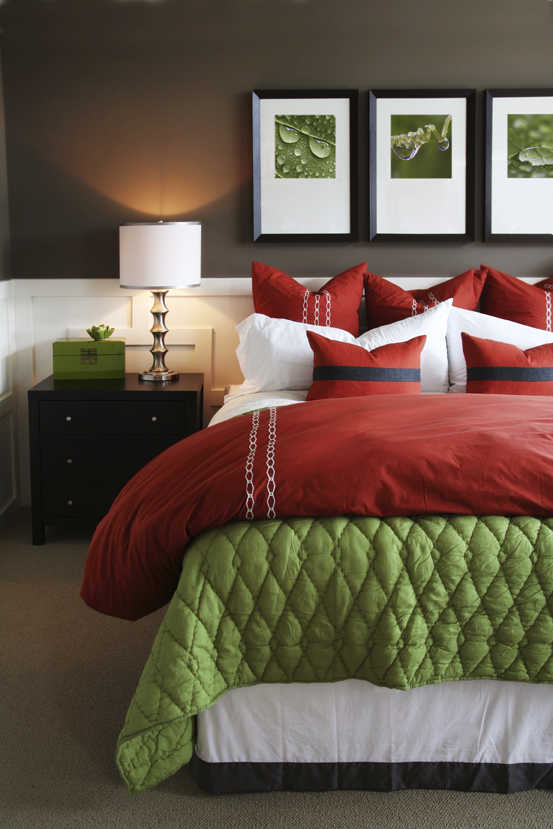 If you spent time and energy finding snazzy sheets, they are generally not something you’ll want to hide beneath the comforter all day long. To show them off, make the bed with the top sheet facing down, then fold the top, finished edge up and over the comforter, quilt or duvet. Offering just a hint of those stylish linens gives the bedding scheme a nicely layered look.
If you spent time and energy finding snazzy sheets, they are generally not something you’ll want to hide beneath the comforter all day long. To show them off, make the bed with the top sheet facing down, then fold the top, finished edge up and over the comforter, quilt or duvet. Offering just a hint of those stylish linens gives the bedding scheme a nicely layered look.
Comforter? Check. Pillows? Shams? Sheets? Check, check, check. Now it’s time to focus a little attention on the end of the bed. The same rules of balance that apply in the rest of the home are relevant here. If you build up the top of your mattress with coordinating patterns and layers of mixed and matched pillows, the opposite end is going to feel pretty off balance. So spend time considering a few additional pieces to bring the whole look together.
There are a few general options in this last phase. One is a folded or draped blanket at the foot of the bed, and the other is a bench or trunk pushed against the edge of the bed frame. If space allows, go with a bench. You’ll be wishing that you had thought of it years ago as you use it to both store your shoes and sit on to put them on. But if space is needed to maneuver around the bed, a luxurious throw blanket is a fabulous way to gain visual balance. Again, keep color scheme in mind, but allow yourself to break a little out of your comfort zone. It’s all about impact here.
Contrary to widely accepted opinion, luxury in the bedroom isn’t as expensive as you’d think. As with any home project, set a budget and stick to it. By shopping around and choosing only one or two big-ticket, big-impact items, you can easily and comfortably create a bed worthy of any home fashion spread.






